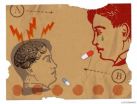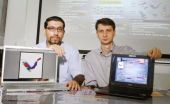(Press-News.org) Most patients who take anti-depressants give up their treatment in less than six months, the minimum period recommended for treating severe depression and other derived pathologies. This is the conclusion of a new study carried out by Catalan researchers, which reveals that only 25% continue their treatment for more than 11 months.
"Only one in every five patients properly completes their treatment", Catalina Serna, co-author of the study, and an expert at the Jordi Gol Primary Care Research Institute (IDIAP) in Lleida, tells SINC.
From 2003 to 2007, researchers from the Catalan Institute of Health (ICS) and the IDIAP Jordi Gol analysed 7,525 patients who were starting anti-depression treatment, looking at how long they continued with this treatment and the reasons why they gave it up.
The results, published this year in the journal European Psychiatry, pointed out that, of the 3.2% of the population who started treatment for depression, 56% stopped taking their medication during the first four months, and less than 25% of the cohort continued their treatment for more than 11 months.
The researchers say patients are most likely to give up their medication during the acute stage of depression (the first months). "The levels to which they stick to their treatment also declines steeply between the first four and 12 months of the monitoring period", Serna points out.
"In our study, only 22% of patients completed their treatment", the expert explains. "The higher completion rates seen in chronic cases are in multiply-medicated patients, who are twice as likely as other patients to continue with their treatment for depression (31% vs. 15.3%).
Men are more likely to give up treatment
Meanwhile, men are more at risk of giving up their treatment earlier than women (50% of men gave up their medication after two months, while 50% of women gave it up after three months).
Depression is one of the commonest psychiatric diseases among adults, above all in industrialised countries. A European study carried out in 2004 found that almost 13% of individuals surveyed reported having a serious depressive illness at some point in their lives. This study revealed that in Spain, where anti-depressant use has risen in line with the availability of new drugs, 10.5% of the population suffers from depression.
INFORMATION:
References:
M. Catalina Serna, Inés Cruz, Jordi Real, Eduardo Gascó, Leonardo Galván. "Duration and adherence of anti-depressant treatment (2003 to 2007) based on prescription data base". European Psychiatry , 25 (2010) 206-213, mayo de 2010.
Alonso J, Angermeyer MC, Bernert S, Bruffaerts R, Brugha TS, Bryson H, et al. "Psychotropic drug utilization in Europe: results from the European Study of the Epidemiology of Mental Disorders (ESEMeD) project." Acta Psychiatr Scand Suppl 2004
More than half of depression patients give up their treatment
2010-11-23
ELSE PRESS RELEASES FROM THIS DATE:
Stability is first step toward treating ALS
2010-11-23
Amyotrophic lateral sclerosis (ALS) is a fatal neurodegenerative disease that eventually destroys most motor neurons, causing muscle weakness and atrophy throughout the body. There is no cure and the current treatment has only a moderate effect on the march of the disease, which typically kills within three to five years. This week in PNAS, a team of Brandeis scientists reports an innovative approach to treating the most common form of familial ALS, commonly known as Lou Gehrig's disease.
In the study, researchers studied mutations in the gene that makes a particular ...
Imaging science offers new opportunities for interdisciplinary collaboration
2010-11-23
Nov. 22, 2010 -- More than 170 participants gathered this week for the eighth annual National Academies Keck Futures Initiative (NAKFI) conference in Irvine, Calif. This year's topic, imaging science, a field of study that uses physics, chemistry, mathematics, computer science, and cognitive sciences to understand the many factors that influence and enable image capture and analysis. At the conference, top researchers from different fields discussed imaging science and its far-reaching applications -- such as astronomy, environmental monitoring, education, and health ...
Protein found to predict brain injury in children on 'ECMO' life support
2010-11-23
Johns Hopkins Children's Center scientists have discovered that high blood levels of a protein commonly found in the central nervous system can predict brain injury and death in critically ill children on a form of life support called extra-corporeal membrane oxygenation or ECMO.
ECMO, used to temporarily oxygenate the blood of patients whose heart and lungs are too weak or damaged to do so on their own, is most often used as a last resort because it can increase the risk for brain bleeding, brain swelling, stroke and death in some patients.
A detailed report of the ...
For HIV-positive patients, delayed treatment a costly decision
2010-11-23
HIV infected patients whose treatment is delayed not only become sicker than those treated earlier, but also require tens of thousands of dollars more in care over the first several years of their treatment.
"We know that it's important clinically to get people into care early because they will stay healthier and do better over the long run," says Kelly Gebo, M.D., M.P.H., an associate professor of medicine in the Division of Infectious Diseases at the Johns Hopkins University School of Medicine and the study's senior author. "But now we know it's also more costly to ...
Study reveals neural basis of rapid brain adaptation
2010-11-23
You detect an object flying at your head. What do you do? You probably first move out of the way -- and then you try to determine what the object is. Your brain is able to quickly switch from detecting an object moving in your direction to determining what the object is through a phenomenon called adaptation.
A new study in the Nov. 21 advance online edition of the journal Nature Neuroscience details the biological basis of this ability for rapid adaptation: neurons located at the beginning of the brain's sensory information pathway that change their level of simultaneous ...
Fall bonefish census sounds warning bell that warrants careful future monitoring
2010-11-23
MIAMI – November 22, 2010 – This October more than 60 guides and anglers in the Florida Keys poled across the flats from Biscayne Bay to the Marquesas, assisting in the annual bonefish census. This year's count, held in extremely difficult weather with lowered visibility, was down by 25-percent from an 8-year mean estimate of 316,805 bonefish to a new low of about 240,000 bonefish, according to Professor Jerry Ault, a fisheries scientist with the University of Miami's Rosenstiel School of Marine & Atmospheric Science.
"Since 2003 we have conducted an annual bonefish ...
Flexible wings driven by simple oscillation may be viable for efficient micro air vehicles
2010-11-23
In the future, tiny air vehicles may be able to fly through cracks in concrete to search for earthquake victims, explore a contaminated building or conduct surveillance missions for the military. But today, designing the best flying mechanism for these miniature aerial machines is still a challenging task.
Creating micro-scale air vehicles that mimic the flapping of winged insects or birds has become popular, but they typically require a complex combination of pitching and plunging motions to oscillate the flapping wings. To avoid some of the design challenges involved ...
Putting the squeeze on fat cells
2010-11-23
From fad diets to exercise programs, Americans continue to fight the battle of the bulge. Now they'll have help from recent Tel Aviv University research that has developed a new method to look at how fat cells -- which produce the fat in our bodies -- respond to mechanical loads.
This might be the key to understanding how to control the amount of fat produced by fat cells, the holy grail of weight loss researchers, says Prof. Amit Gefen of Tel Aviv University's Department of Biomedical Engineering. His research is driven by the theory that fat cells, like bone or muscle ...
Scientists clock on to how sunlight shapes daily rhythms
2010-11-23
Fresh insight into how biological clocks adjust to having less sunlight in the winter could help us better understand the impact of jet lag and shift work.
Scientists studying the daily activity cycle in plants – known as circadian rhythms – have discovered a finely tuned process that enables the plant's genes to respond to the times of dawn and dusk each day, as well as the length of daylight in between.
This system helps the plant to reset its internal clock every day in response to seasonal changes in daylight, which helps the plant control the timing of key activities ...
Bacteria help infants digest milk more effectively than adults
2010-11-23
Infants are more efficient at digesting and utilizing nutritional components of milk than adults due to a difference in the strains of bacteria that dominate their digestive tracts. Researchers from the University of California, Davis, and Utah State University report on genomic analysis of these strains in the November 2010 issue of the journal Applied and Environmental Microbiology identifying the genes that are most likely responsible for this difference.
"Human milk oligosaccharides (HMOs) are the third-largest solid component of milk. Their structural complexity ...



